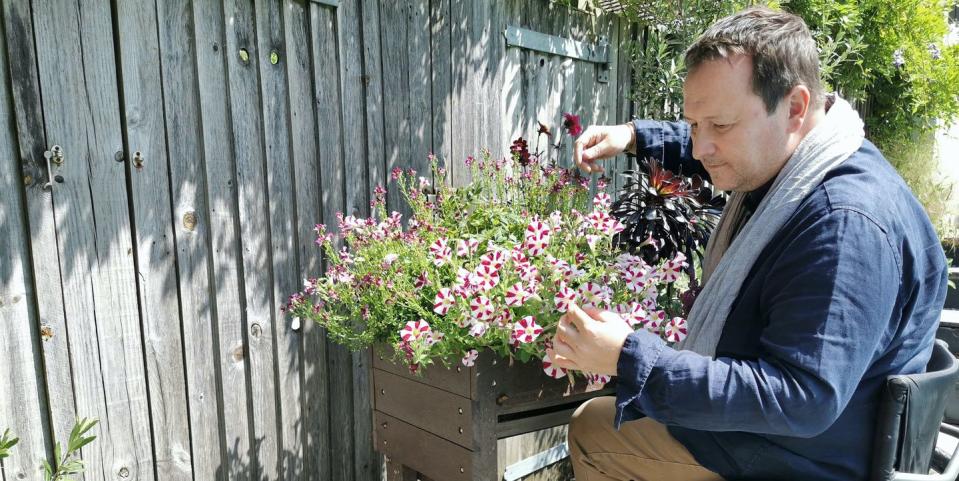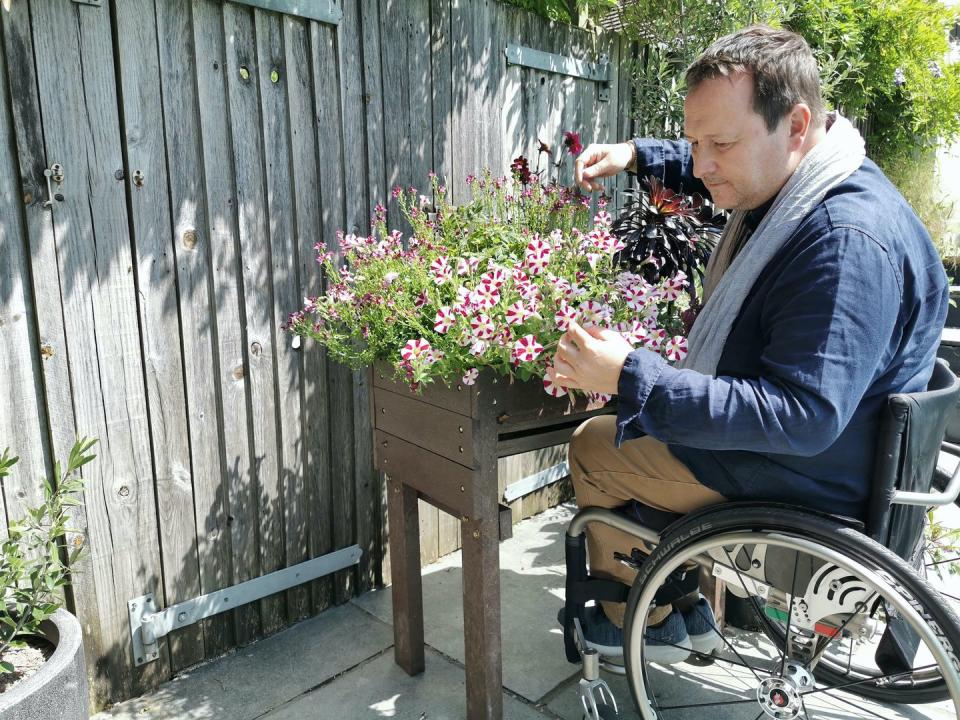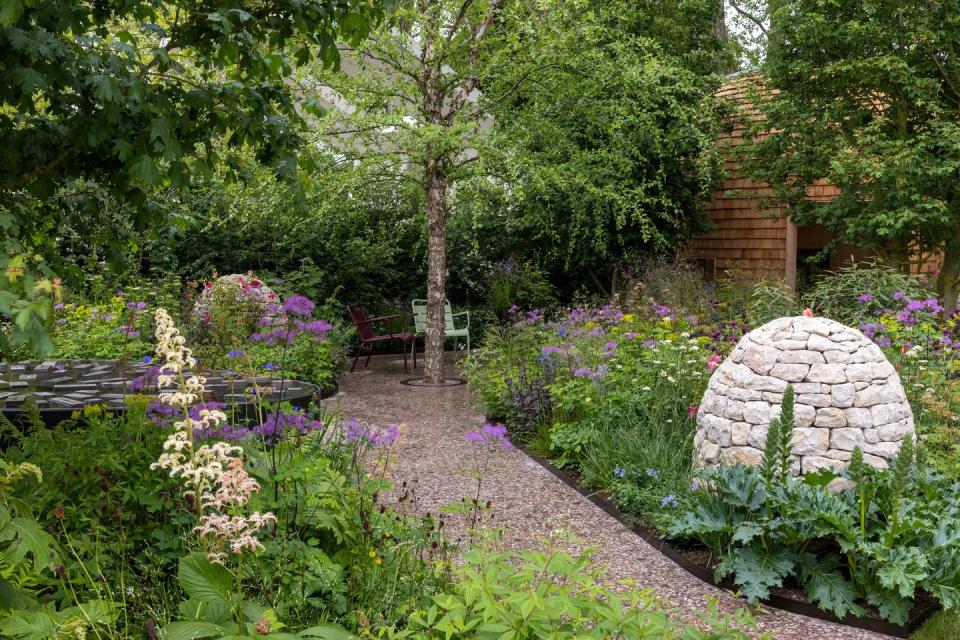How to design an accessible garden, according to Gardeners' World's Mark Lane

Steps, steep slopes and uneven ground are just a few hazards that can make gardens unsafe and impractical for people with mobility issues. But, with changes to layout and design, there are some achievable ways to create a secure space that's accessible for all.
'If you love gardening but your body is starting to ache in areas that never ached before or you find yourself needing to use a walking frame, stick or wheelchair, then what should be a wonderful creative past-time can turn into a nightmare of a project. With some planning, you can create the outdoor space of your dreams,' says Mark Lane, landscape designer, Gardeners' World presenter and ambassador for Thrive, a disability charity that uses gardening to positively change lives.
The design of your garden can create a huge difference to your enjoyment of it. Here are some top tips to help you out...
1. Get to know your body
When designing your garden, it's important to create a space that will work for you. You should consider how far you can reach, whether you will want to sit down, or if you might need a ramp to provide ease.
'Assess yourself and see how far you can reach, bend or lean forward,' says Mark. 'Can you twist your torso? Can you twist your wrist? Are you able to kneel on a comfy pad or cushion? Are you able to push yourself up again? Once you know what it is you can do, then the outdoor space will be much easier and can be created around you.
'For example, if you cannot twist your body and need, or would prefer, to sit down when gardening, then a raised bed with flat sides isn't advisable. Instead, go for a raised table or manger so that you can get your knees underneath and work at a comfortable height without having to twist or turn.'

2. Take measurements of your space
As you design your dream garden, take measurements of your space (or ask someone to help you). See where the sun comes up and where shadows fall to enable you to work out exactly where to position garden furniture. Consider whether there's a specific view you'd like to see from your kitchen window, such as a pretty flowerbed or bird bath, for example, and think about the size of your patio or paved area, ensuring it's big enough for a table and chairs.
3. Create a pathway for purpose
Hard standings such as pathways, turning circles, ramps and steps, really are essential when creating safe, accessible gardens for the elderly, wheelchair users, or those less able. 'Make sure they are wide enough to take a wheelchair or buggy and someone walking by the side,' notes Mark. 'In an ideal world, this would be between one and a half, and two metres wide.'
Paths should also have gradual, easy curves, instead of sharp corners — this will make it easier for people navigate a garden. Consider adding handrails to steps and level changes for extra stability. And similarly, enclosing your decking with secure balustrades is a practical measure to reduce the chances of tripping and causing injury.
A great example of accessible garden design was seen in Horatio's Garden designed by Charlotte Harris and Hugo Bugg at the RHS Chelsea Flower Show 2023. This adaptive garden put the priorities of all those with different mobility needs at its heart, with accessible, wide paths, which not only allowed for pain-free movement, but also easy navigation by patients in beds, wheelchairs, or by those learning how to walk again.

'For the pathway, consider paving slabs rather than gravel, as little stones are very difficult for wheelchair wheels to navigate,' says Mark. 'Paving should be pointed with a minimum gap of 10mm. You want a firm, stable, non-slip surface. In some instances, anti-glare paving slabs are a good idea — especially for partially sighted or blind people.'
4. Opt for raised beds and elevated gardening
Raised beds will boost drainage, create the perfect foundation to grow a wide range of plants, and provide accessibility to wheelchair users as it lifts the garden up to a manageable height.
Mark advises that you shouldn't make raised beds any wider than 1.2m, especially if you can only access it from one side.
'Add a raised edge to your pathways. This is great for wheels, feet and tapping with a cane,' he says. If you use treated softwood sleepers laid on their longer flat edge, you can create a perching spot all the way around the soil area, enabling you to garden while sitting down. If you're using brick or blockwork, try and aim for a frame that's 20-30cm wide, which is just big enough to perch on.
5. Make lighting a priority
Lighting should always be a key consideration inside and outside the home. Think about the use of wall lights, which should be placed by your garden door, but also position these in corners or nooks of your outdoor space that will often get dark. To line pathways and create a clear direction of travel for wheelchair users, invest in stake lights or outdoor strip lights to illuminate paths or decking steps.
David Hough from home improvement specialists, SMART Balustrades, stresses the importance of using lighting around the garden to improve accessibility for the darker days and nights.
'The patio area can often be slippery when wet, and hard structures can hurt when banged into, so installing lighting to this area is recommended,' he says. 'Festoon and string lights are popular options for both balcony and garden owners, as they can be easily hung from surrounding structures.'

6. Invest in a self-watering system
If you're struggling to reach certain flowers, or don't have the time to water them, a self-watering system is definitely worth investing in. 'You need an irrigation system (for example, a leaky hose or small irrigation pipes and nozzles that drip-feed and nourish your plants) plus a water collecting reservoir at the bottom,' explains Mark.
Follow House Beautiful on TikTok and Instagram.
You Might Also Like

 Yahoo Finance
Yahoo Finance 
